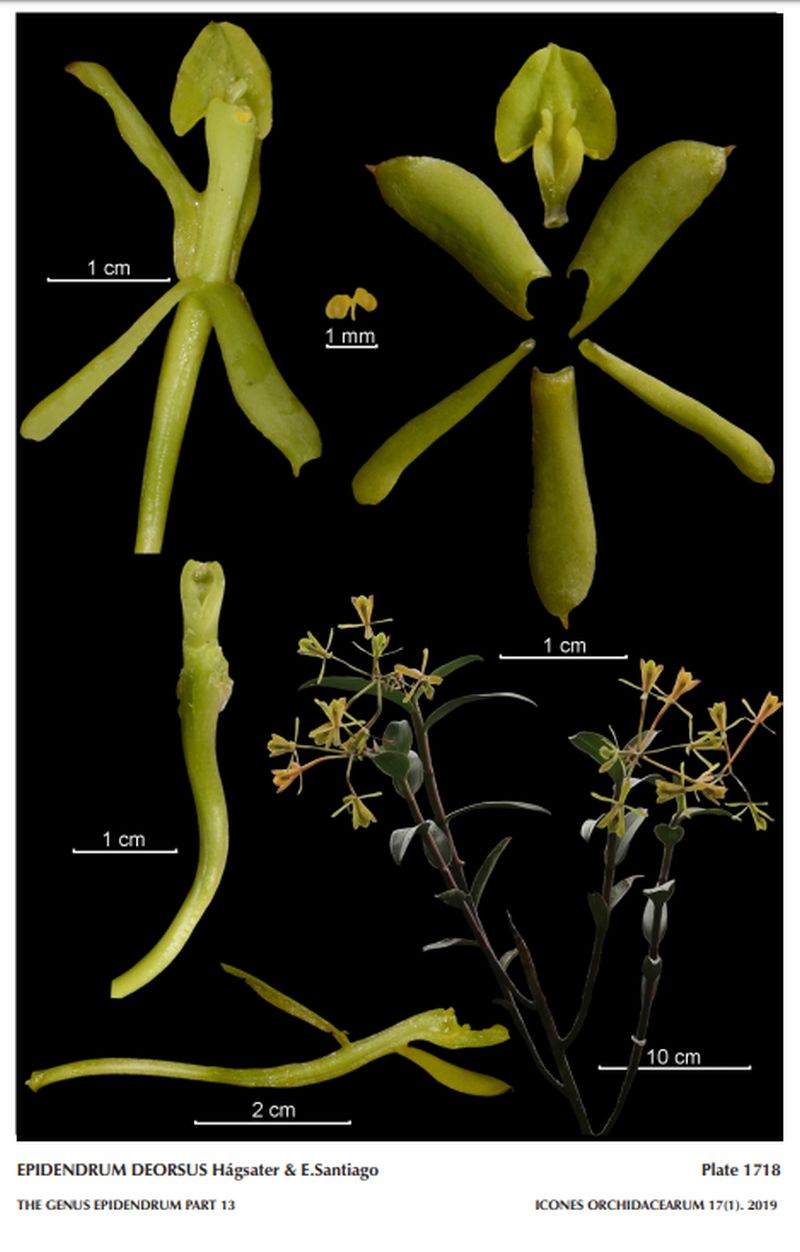

Epidendrum deorus Hágsater & E.Santiago 2019 GROUP Andean SUBGROUP Vernixium
LCDP Photo by © E. Hágsater & A. Cisneros/TYPE Photo by © Eric Hagsater and AMO Herbaria Website





Common Name The Downwards Facing Epidendrum [in reference to the non-resupinate flowers with the lip always facing downwards]
Flower Size 1.2" [3 cm]
Found in Peru in the central wet forests in the municipality of Oxapampa, at elevations of 2100 to 2471 meters altitude on roadside banks with other orchids and in low montane forest and meadows with Xyris sp., Eriocaulaceae and Trichomanes lucens Sw. as a giant sized, cold growing terrestrial with cane-like, branching sub-apically, terete, erect, straight; the primary stem 68" x .24 to .48" [170 x 0.6 to 1.2 cm], branches 8 to 16" x .12 to .4" [20 to 40 x 0.3 to 1.0 cm], base covered by tubular, non-foliar sheaths and carrying numerous and larger on the primary stem, 8 to 10 on the branches, distributed throughout the stems, alternate, articulate, sub-coriaceous, green, concolor, spreading; sheaths tubular, minutely striated, rugose, tinged reddish brown; blade oblong-elliptic, obtuse, margin entire, spreading leaveas that blooms in the spring summer and fall on a terminal, without a spathe, peduncle .48 to .6" [1.2 to 1.5 cm] long, terete; rachis 2.4 to 3" [6.0 to 7.5 cm] long. 2.8 to 3.6" [7 to 9 cm] long, apical, racemose, slightly arching-nutant, simultaneously 17 to 20 flowered inflorescence with much shorter than the ovary, narrowly triangular, acuminate, embracing floral bracts and carrying non-resupinate, spreading horizontally with the lip always facing downwards, fleshy, green, turning ochre-yellow with age flowers.
"Epidendrum deorsus belongs to the GROUP Andean SUBGROUP Vernixium which is characterized by the monopodial, sub-apical branching habit, erect inflorescences, lax, non-resupinate flowers, and the lip entire to 3-lobed. The new species is recognized by the ovate-elliptic leaves, short inflorescence, the non-resupinate, horizontally spreading flowers on an ovary 1.6" [40 mm] long, the lip always facing downwards, sepals .84" [21 mm] long, and especially by the entire, cordiform lip .4 x .4" [10 x 10 mm], with a single wide, thickened midrib that reaches the apex of the lip. Epidendrum elatum C.Schweinf. widespread from Bolivia to Colombia has ovate-oblong to elliptic-lanceolate leaves, flowers non-resupinate but upright, but a lip deeply 3-lobed, disc with 3 narrow ribs, lateral lobes of the lip dolabriform with radiating thickened veins. Epidendrum citrochlorinum Hágsater & Dodson from Ecuador has shorter ovaries, .88" [22 mm] long, smaller flowers, sepals .58 to 6.2" [14.5 to 15.5 mm] long, an entire, reniform, cordate lip 3.52 x .58" [8.8 x 14.5 mm]. Epidendrum chaoticum Hágsater & E.Santiago has the ovary 1.2" [30 mm] long, successive flowers non-resupinate, erect, sepals .8" [20 mm] long, lip .48 x .4" [12 x 10 mm], sub-quadrate, calli narrow, elongate, curved, surrounded by 6 short thickened radiating veins." Hagsater etal 2019
Synonyms
References W3 Tropicos, Kew Monocot list , IPNI ; * Icones Orchidacearum 17(1) Plate 1718 Hagsater & Jimenez 2019 drawing/photo fide; Icones Orchidacearum 18(1) plate 1801 2020 see recognition section; Icones Orchidacearum 18(2) Plate 1896 Hagsater & Jimenez 2021 see recognition section
--------------------------------------------------------------------------------------------------------------------------